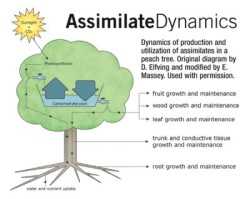Stone Fruit: Are You Stressed?

When you drive through the orchard and see trees that are performing poorly or dying, it can be a source of tremendous stress to you as a grower. For the trees you just observed, they too, may be experiencing significant stress!
Plant stress is driven by numerous factors that adversely affect plant health, growth, productivity, and survival. Some stress factors directly impact tree assimilate dynamics (acquisition and utilization of water, nutrients, energy, and carbohydrates — see figure). These factors are living (biotic) or non-living (abiotic). Often, multiple stress factors can occur simultaneously or successively. Some stresses are chronic (systemic viral infection) while others may be acute (temporary drought).
Avoiding Stress
The first key to managing orchard stress is to avoid it in the first place through good management. Indeed, many stressful orchard conditions can be avoided if you choose a good site, pre-plant fumigate the soil, and choose the proper rootstock. Further, choosing the correct cultivar based on chill hours for your region and pest/disease tolerance is vital. Planting trees at the proper soil depth (graft union 4 inches above soil line) is necessary to keep feeder roots in the proper soil zone and to enhance tree stability.
Careful use of orchard machinery and proper timing and use of pruning tools can minimize damage to tree trunks and promote rapid healing of wounds on scaffold branches and limbs, respectively. Proper crop load management through pruning and thinning can facilitate strong scaffolds that won’t break under the pressure of a heavy crop. Finally, careful weed, pest, and disease management combined with adequate water and fertility can help to keep trees productive and healthy.
When speaking about orchard stress, it is also important to make several distinctions. It may be localized (part of a single tree or a few trees near each other) or it may be widespread (hundreds of trees in a low spot where there was standing water). One type of stress can exacerbate another — for example, trees that have been hit by hail causing numerous bark and trunk wounds provide attractive sites for lesser peach tree borer females to lay eggs or disease entry.
Some types of stress are reversible (i.e., nitrogen deficiency) while others (systemic viral infection) will persist throughout the life of the tree. It is also important to consider the timing of stress relative to key phenological growth stages. For fruit during the period of final swell (last two weeks before harvest), drought stress could have a very significant adverse impact on final fruit size. In severe cases of heat/drought stress, trees may actually drop fruit prematurely.
Identifying Stress
A key to managing orchard stress is being able to identify what is occurring with the goal of rectifying the situation or managing it to the greatest extent possible. There are numerous biotic stresses that adversely impact peach trees. These include insects, fungal diseases, bacterial diseases, viruses, viroids, mycoplasmas, nematodes, weeds, and even browsing animals (i.e., deer). There are numerous abiotic stresses, as well. These include solar radiation (sunburn), air and soil temperature (too hot or cold), inadequate chilling, rainfall (too much or too little), soil pH (too high or low; 6-7 usually best), soil nutrition (deficiency or excess), soil structure and aeration, excess wind, hail, herbicide drift, and even air pollution (ozone, sulfur dioxide, and hydrogen fluoride).
Finally, it is of vital importance to deal with factors that you can control and to consider the long-term impact on the tree. For example, if a block is compromised by hail, abandoning it until next year without a minimal fungicide/insecticide program to protect the tree and help minimize wound infection or boring of insects would be unwise. Some modest efforts could help to facilitate healing and significant recovery for cropping next year. Keeping good records from one year to the next by block will help to remind you of trees that had problems, what corrective measures were taken, and what the response was. Lastly, try to learn from and not repeat errors. We all make them but the wise person learns from them and doesn’t repeat them.










